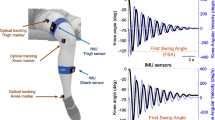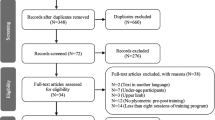Abstract
Acupuncture is a traditional Chinese therapeutic method, recognized by western medicine as an important complementary therapy. However, the efficacy assessment of this traditional intervention has been mainly empirical rather than scientific. In this paper, we propose a surface electromyography (sEMG) based approach for quantitative assessment of acupuncture on Bell’s palsy. The assessment is made by comparing the muscle activities of healthy with diseased ones. A feature-vector of four individual sEMG features is introduced for more comprehensive representation of muscle activity. A clustering technique is then proposed to calculate quantitative differences between the muscle activities of the healthy and diseased sides. A regressive model is also proposed to predict the recovery trend of a patient based on the quantitative assessments during his/her clinical acupuncture history. As reported in the paper, a total of 20 selected Bell’s palsy patients have participated in the extensive experiments that were conducted to verify the performance of the proposed method.
摘要
针刺是一种传统的中医治疗手段, 已经在临床上得到广泛的应用. 但是, 针刺疗效目前缺乏客观精确的量化评估方法. 本文提出一种基于表面肌电信号的针刺治疗面瘫疗效量化评估方法, 主要包括以下几个部分: 首先, 采集患者健康侧与患侧的表面肌电信号, 并提取特征, 组建特征向量; 然后, 采用主元分析和 k均值方法, 对特征向量进行降维聚类, 以类别中心距离作为评估针刺疗效的指标; 最后, 利用类别中心距离构造自回归模型, 预测患者的康复趋势. 20 名面瘫患者参与到本实验中, 验证上述方法. 结果表明, 本文方法预测精度达到 92.8%以上.
Similar content being viewed by others
References
World Health Organization. Acupuncture: Review and Analysis of Reports on Controlled Clinical Trials. Geneva: World Health Organization, 2002. 1–5
Ezzo J, Berman B, Hadhazy V A, et al. Is acupuncture effective for the treatment of chronic pain? A systematic review. Pain, 2000, 86: 217–225
Moffet H H. Traditional acupuncture theories yield null outcomes: a systematic review of clinical trials. J Clin Epidemiol, 2008, 61: 741–747
van Tulder M W, Cherkin D C, Berman B, et al. The effectiveness of acupuncture in the management of acute and chronic low back pain. A systematic review within the framework of the Cochrane Collaboration Back Review Group. Spine, 1999, 24: 1113–1123
Ernst E, Lee M S, Choi T Y. Acupuncture: does it alleviate pain and are there serious risks? A review of reviews. Pain, 2011, 152: 755–764
Xia F, Han J L, Liu X D, et al. Prednisolone and acupuncture in Bell’s palsy: study protocol for a randomized, controlled trial. Trials, 2011, 12: 158–159
Lei H, Wang W, Huang G. Acupuncture benefits a pregnant patient who has Bell’s palsy: a case study. J Altern Complement Med, 2010, 16: 375–395
Hsieh C L. Acupuncture as treatment for nervous system diseases. BioMedicine, 2012, 2: 51–57
Wu B, Li N, Liu Y, et al. Study on clinical effectiveness of acupuncture and moxibustion on acute Bell’s facial paralysis: randomized controlled clinical observation (in Chinese). Chin Acupunct Moxibustion, 2006, 26: 157–160
Li Y, Li Y, Liu L A, et al. Acupuncture and moxibustion for peripheral facial palsy at different stages:multi-central large-sample randomized controlled trial (in Chinese). Chin Acupunct Moxibustion, 2011, 31: 289–293
De Luca C J. Physiology and mathematics of myoelectric signals. IEEE Trans Biomed Eng, 1979, 26: 313–325
Wang T M, Tao Y, Chen Y. Research status and development trends of the service robotic technology (in Chinese). Sci Sin Inform, 2012, 42: 1049–1066
Xiong A B, Chen Y, Zhao X G, et al. A novel HCI based on EMG and IMU. In: Proceedings of IEEE International Conference on Robotics and Biomimetics, Phuket, 2011. 2653–2657
Latif R, Sanei S, Shave C, et al. Classification of temporomandibular disorder from electromyography signals via directed transfer function. In: Proceedings of International Conference of IEEE Engineering in Medicine and Biology Society, Vancouver, 2008. 2904–2907
Rancan S V, Bataglion C, Bataglion S A, et al. Acupuncture and temporomandibular disorders: a 3-month follow-up EMG study. J Altern Complement Med, 2009, 15: 1307–1310
Ferrarin M, Carpinella I, Rabuffetti M, et al. Unilateral and bilateral subthalamic nucleus stimulation in Parkinson’s disease: effects on EMG signals of lower limb muscles during walking. IEEE Trans Neural Syst Rehabil Eng, 2007, 15: 182–189
Zhao F, Fan X, Grondin R, et al. Improved methods for electroacupuncture and electromyographic recordings in normal and parkinsonian rhesus monkeys. J Neurosci Methods, 2010, 192: 199–206
Politti F, Amori C F, Calili L, et al. The use of surface electromyography for the study of auricular acupuncture. J Bodyw Mov Ther, 2010, 14: 219–226
Wang M, Loo W T, Chou J W. Electromyographic responses from the stimulation of the temporalis muscle through facial acupuncture points. J Chiropr Med, 2007, 6: 146–152
Al-Timemy A H, Bugmann G, Escudero J, et al. Classification of finger movements for the dexterous hand prosthesis control with surface electromyography. IEEE J Biomed Health Inform, 2013, 17: 608–618
Li Z J, Wang B C, Yang C G, et al. Boosting-based EMG patterns classification scheme for robustness enhancement. IEEE J Biomed Health Inform, 2013, 17: 545–552
Ding Q C, Zhao X G, Han J D. EMG-based estimation for multi-joint continuous movement of human upper limb (in Chinese). Robot, 2014, 36: 469–476
Duda R O, Hart P E, Stock D G. Pattern Classification. 2nd ed. New York: Wiley-Interscience, 2000. 113–115
Zhou Z M, Ma N, Li Y X, et al. Variational PCA fusion for Pan-sharpening very high resolution imagery. Sci China Inf Sci, 2014, 57: 112107
MacKay D J C. Information Theory, Inference and Learning Algorithms. Cambridge: Cambridge University Press, 2004. 284–292
Sall J, Creighton L, Lehman A. JMP Start Statistics: a Guide to Statistics and Data Analysis Using JMP and JMP in Software. 3rd ed. Cary: SAS Publishing Inc., 2005. 161–168
Englehart K, Hudgin B, Parker P A. A wavelet-based continuous classification scheme for multifunction myoelectric control. IEEE Trans Biomed Eng, 2001, 48: 302–311
Huang Y H, Englehart K B, Hudgins B, et al. A Gaussian mixture model based classification scheme for myoelectric control of powered upper limb prostheses. IEEE Trans Biomed Eng, 2005, 52: 1801–1811
Cattell R B. The scree test for the number of factors. Multivariate Behav Res, 1966, 1: 245–276
Chen X, Li Y, Zheng H, et al. A randomized controlled trial of acupuncture and moxibustion to treat Bell’s palsy according to different stages: design and protocol. Contemp Clin Trials, 2009, 30: 347–353
Author information
Authors and Affiliations
Corresponding author
Rights and permissions
About this article
Cite this article
Han, J., Xiong, A., Zhao, X. et al. sEMG based quantitative assessment of acupuncture on Bell’s palsy: an experimental study. Sci. China Inf. Sci. 58, 1–15 (2015). https://doi.org/10.1007/s11432-015-5282-1
Received:
Accepted:
Published:
Issue Date:
DOI: https://doi.org/10.1007/s11432-015-5282-1




